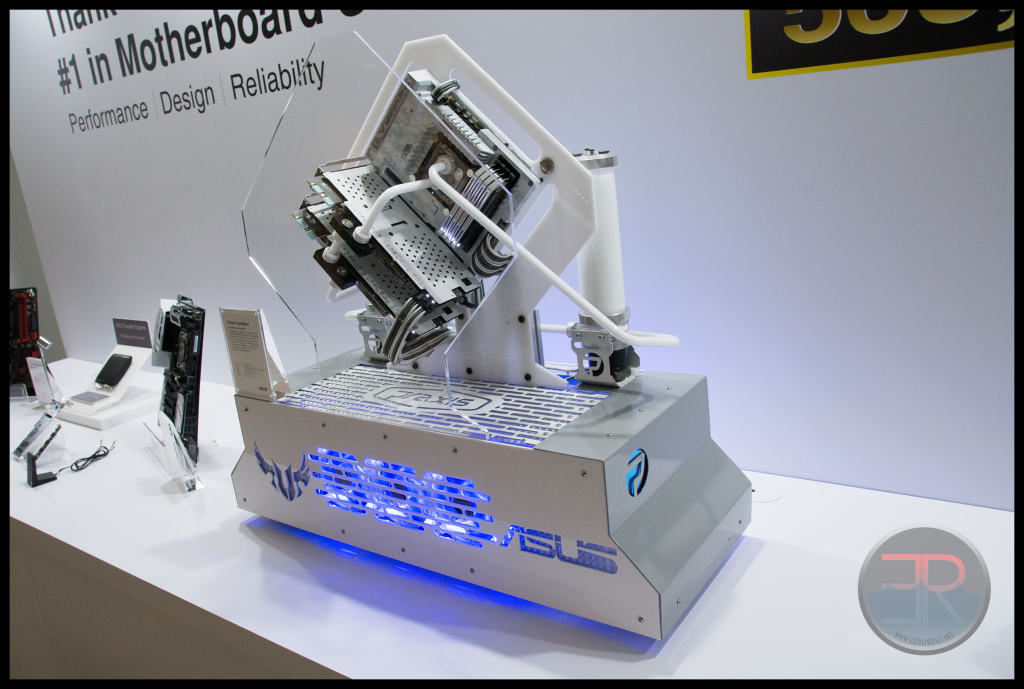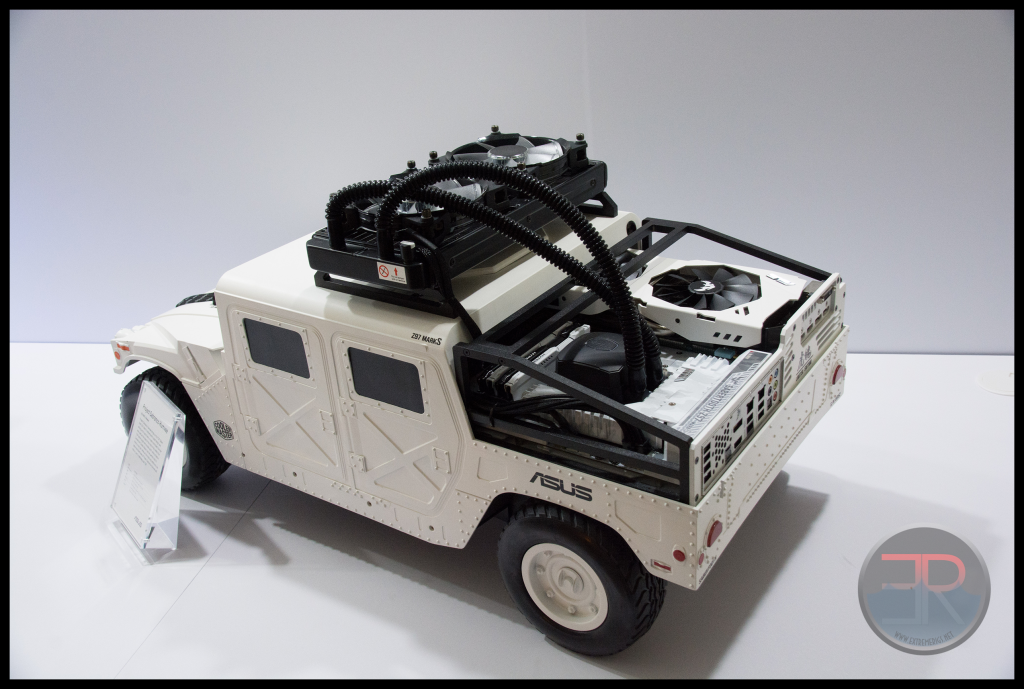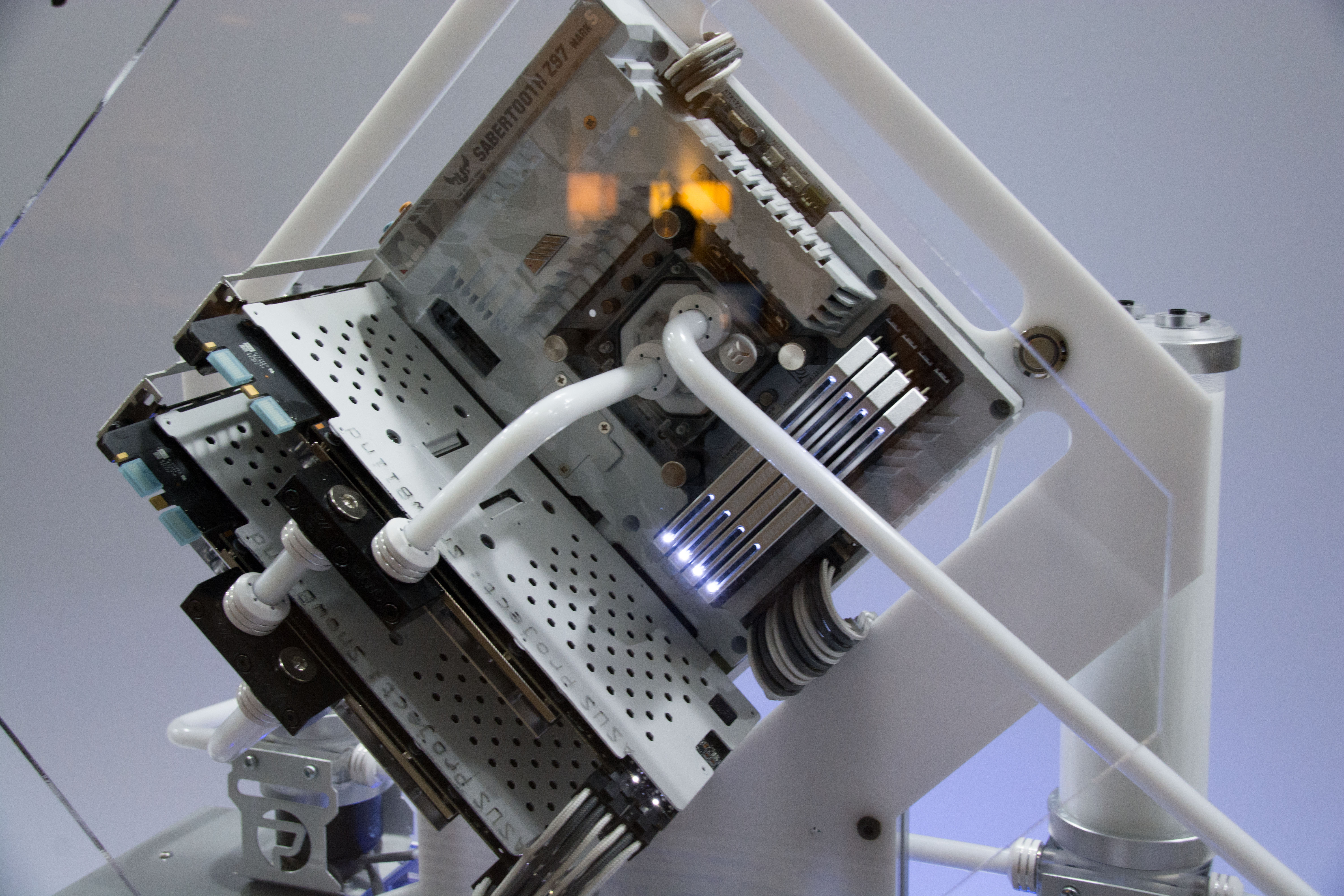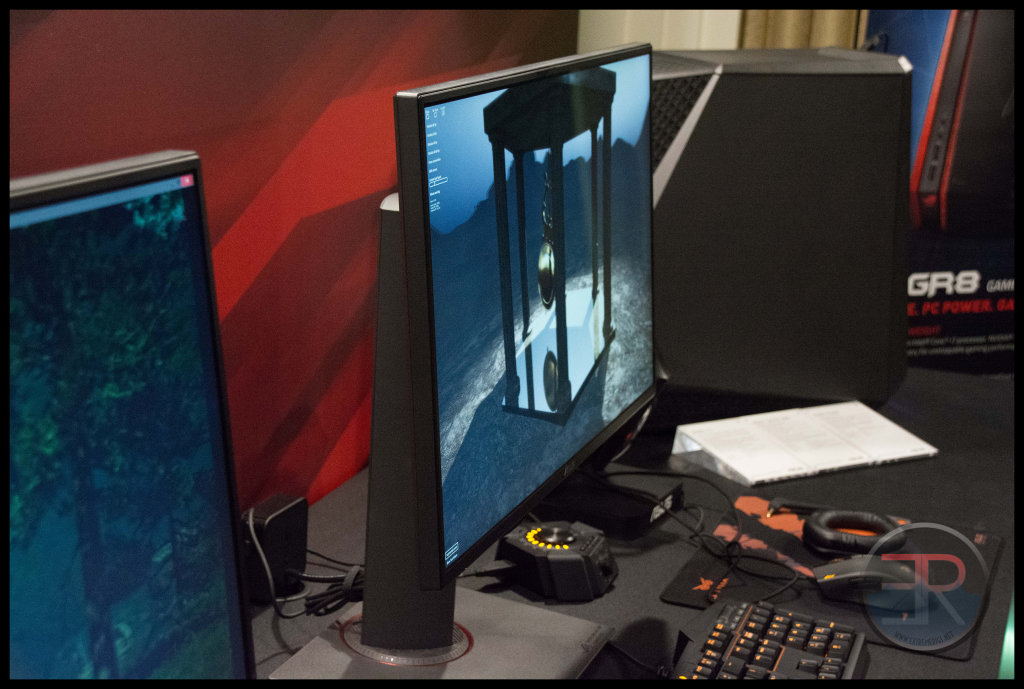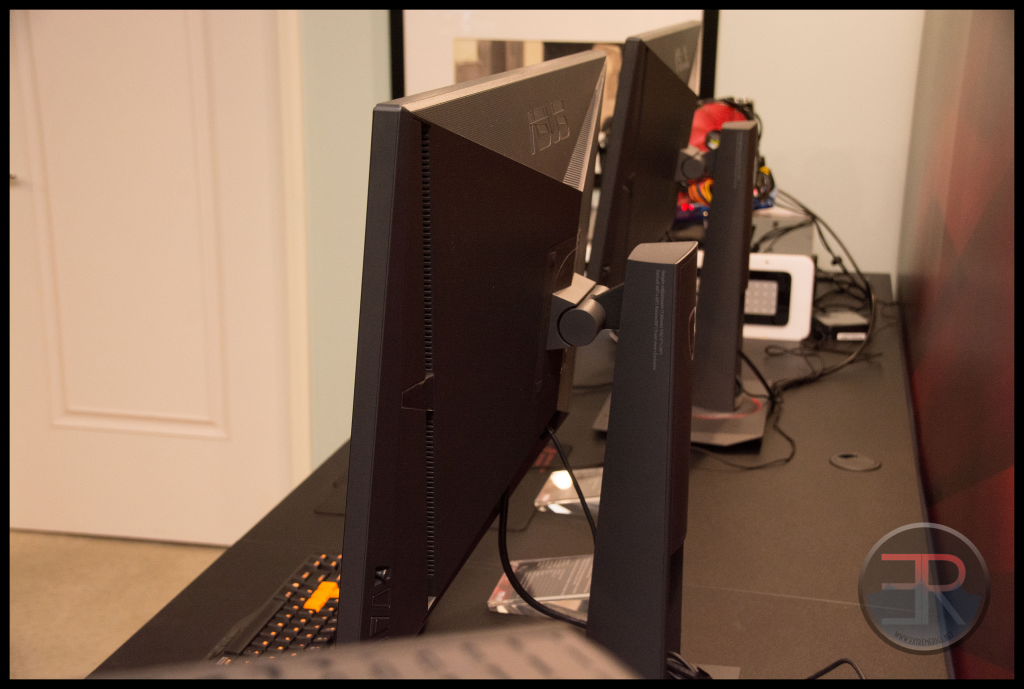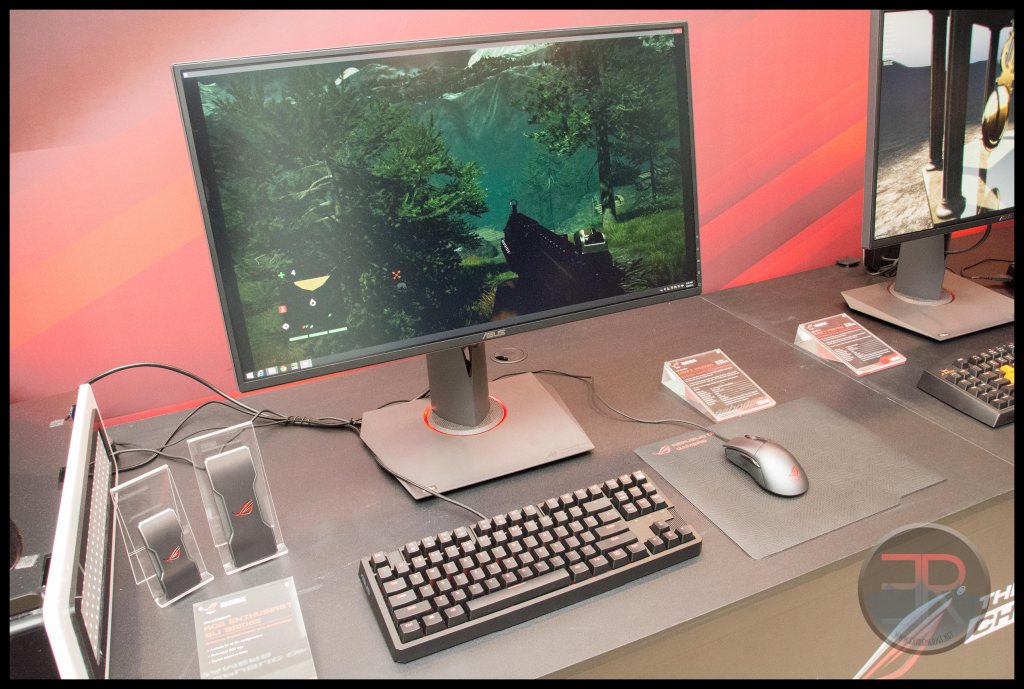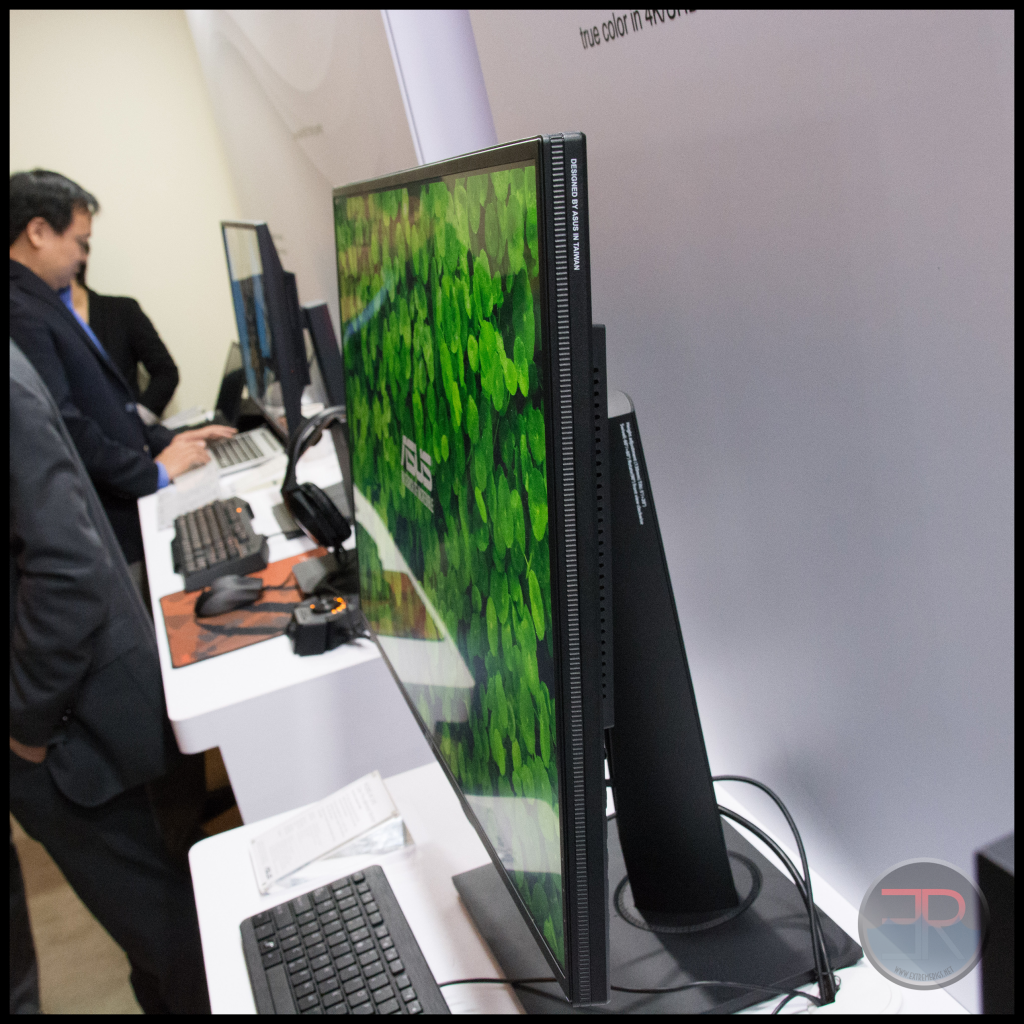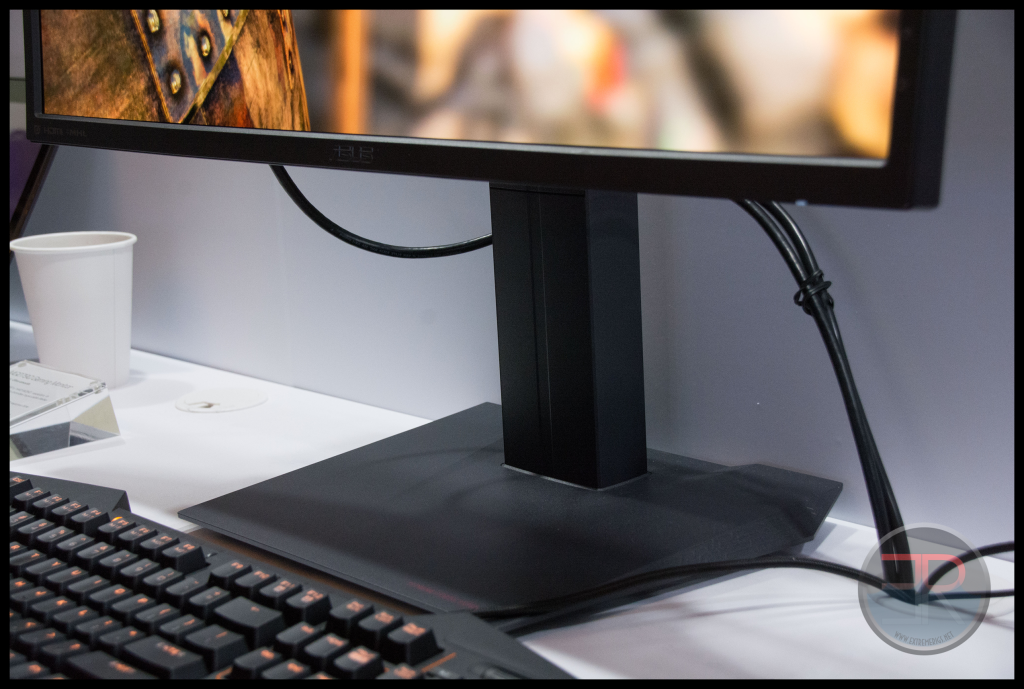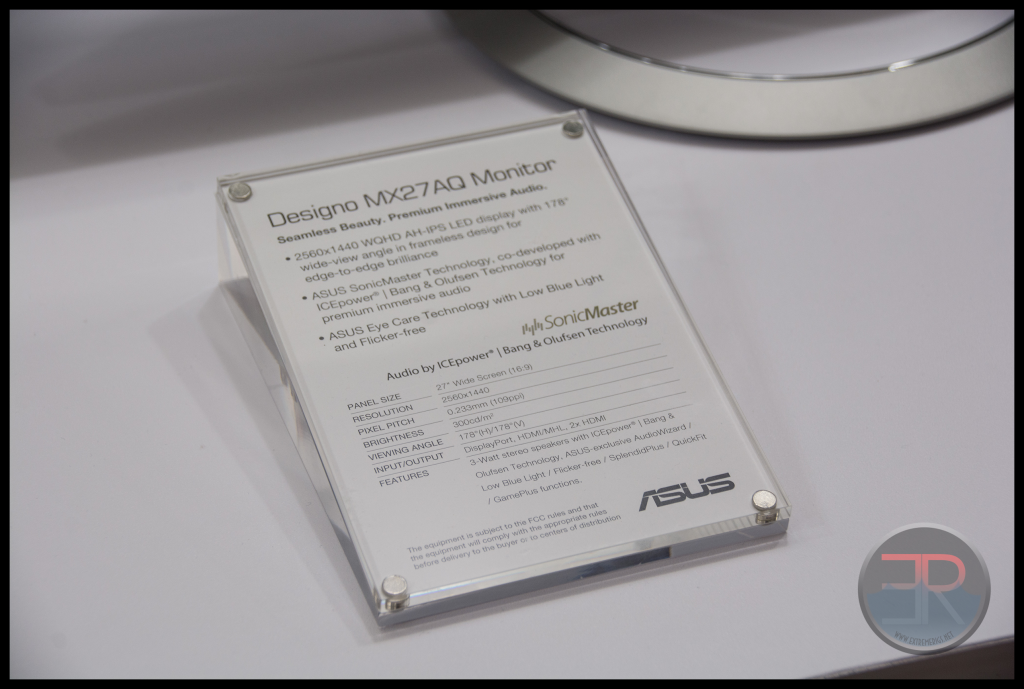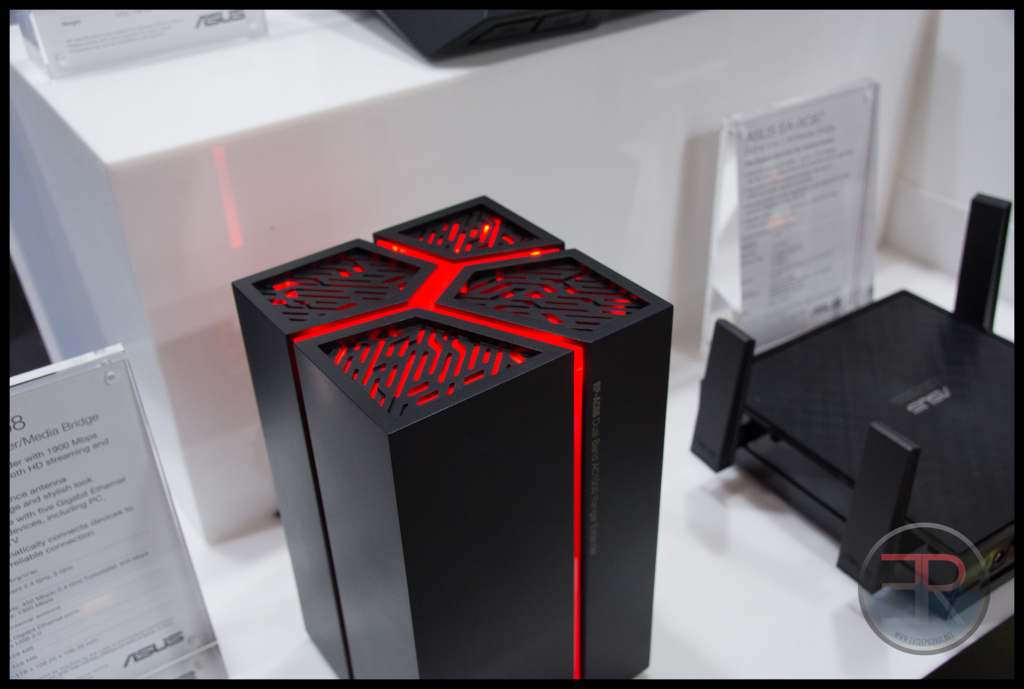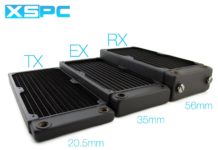Asus don’t really need an introduction. Afterall they dominate the market with their motherboards, and have expanded into laptops, peripherals, sound and displays. Today we’ll be reviewing what was on show in the CES suite. But before we get started, I wanted to mention just how passionate and excited about their products the Asus guys were. Normally after a few days at CES the people you talk to are bored and tired of it. But the passion really shone through at Asus, and the detail to which they thought about things was evident. I was really impressed by the Asus team, and I don’t say that lightly. It sounds like I’m brown nosing, but if you know me, I’m usually the guy who comes across quite cynically. So I’m not the type to do that, so know that I’m being honest and was genuinely impressed with their team.
Now because the X99 and GTX980 launch were quite recent, there was nothing truly new on the hardware side. The really new and exciting stuff were the displays.
Asus last year had been showing the ROG Swift monitor – the 1440p TN based screen with GSync and 144Hz capabilities as well as the more important Lightboost/ULMB technology. This was by far the best monitor ever for FPS gaming. Demand far exceeded supply when it finally did launch as there was no competition (and a few bad units too) and displays on ebay were trading hands for 300-400 above MSRP for what was already not a cheap display (now $800 excluding tax in most stores).
This year Asus introduced another Swift branded display with the PG27AQ:
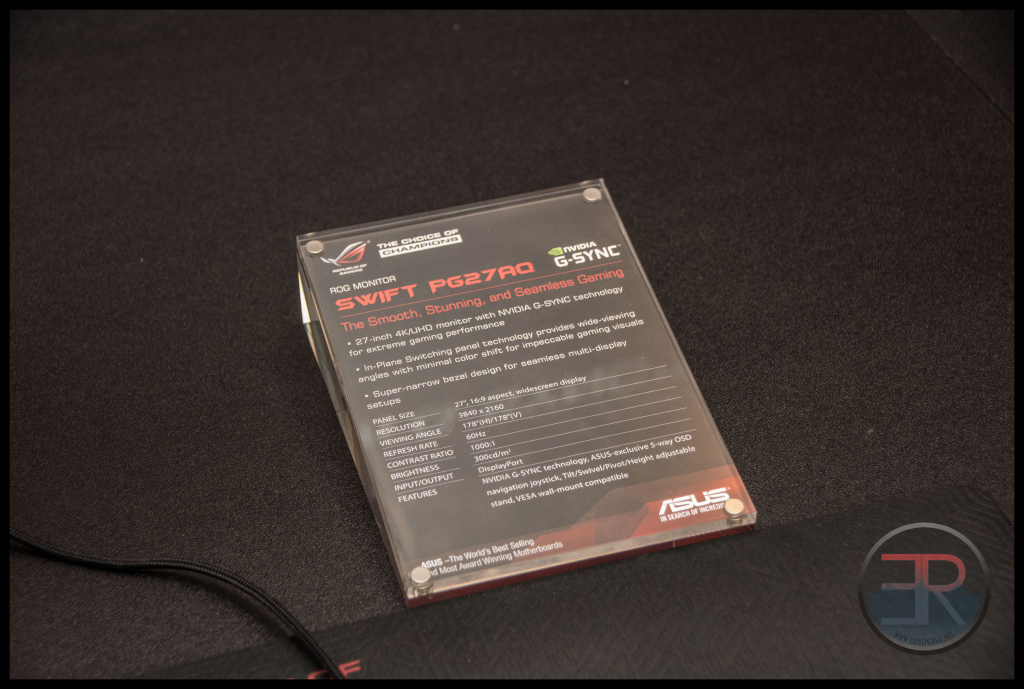 Yes you can almost read that correctly – 4K, IPS, Gsync, 90 degree rotation, vesa mount and guess what, bezels are small too:
Yes you can almost read that correctly – 4K, IPS, Gsync, 90 degree rotation, vesa mount and guess what, bezels are small too:
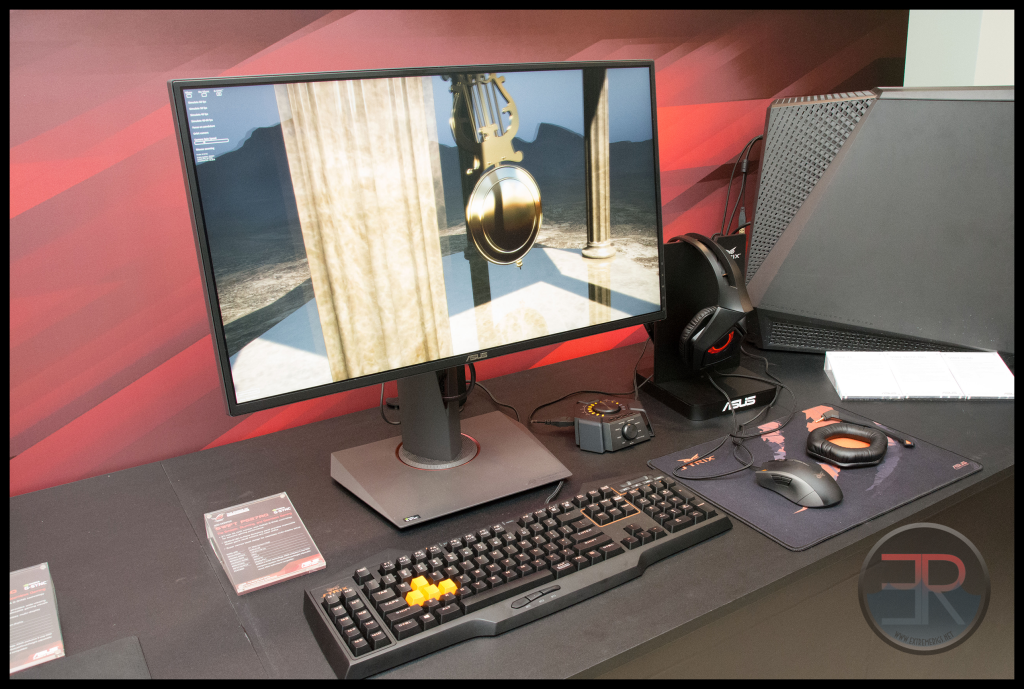 Given that display port doesn’t handle more than 60Hz, then this is really the perfect 4K multi use monitor for gaming and photo/video editing. The downsides – well obviously it’s not going to perfectly calibrated, it’s only 27″ and the price won’t be cheap either. We’d love to see a 32″ version to be honest, but then we’d love free ice cream and flying cars too. Everything in good time.
Given that display port doesn’t handle more than 60Hz, then this is really the perfect 4K multi use monitor for gaming and photo/video editing. The downsides – well obviously it’s not going to perfectly calibrated, it’s only 27″ and the price won’t be cheap either. We’d love to see a 32″ version to be honest, but then we’d love free ice cream and flying cars too. Everything in good time.
The base of course continues the ROG theme and lights up:
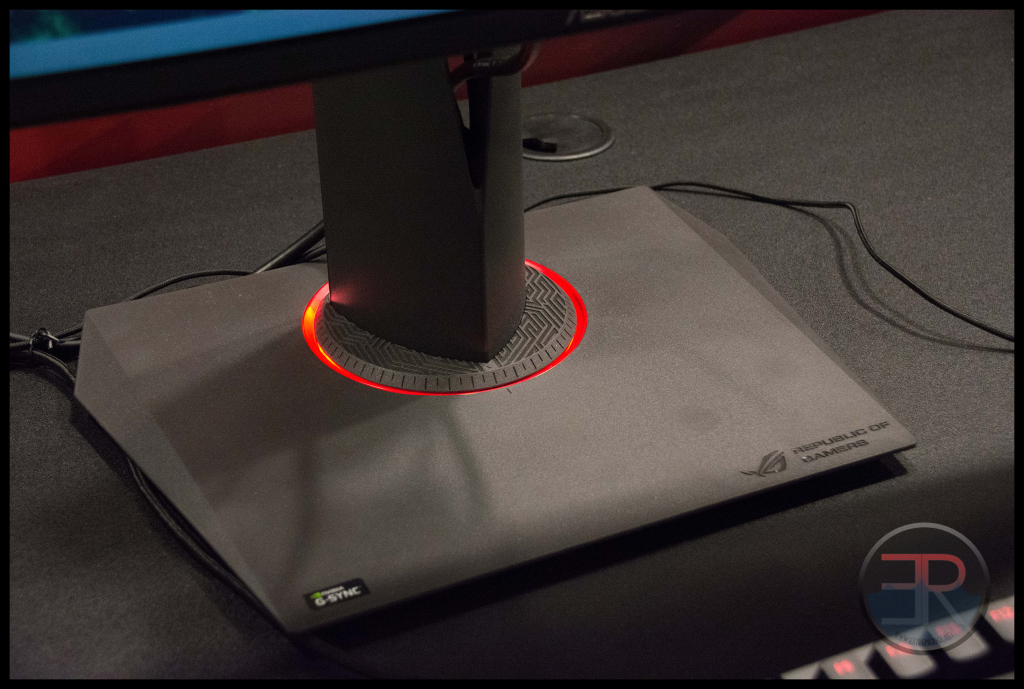 The bottom bezel is a tiny bit thicker than the sides, but it’s still really small, so this is perfect if you’re looking for a 3+ in portrait setup. Plus for 3 in portrait you’re going to need IPS and Gsync/freesync because let’s be honest pushing 60FPS with 3+ 4K displays is going to be *hard*:
The bottom bezel is a tiny bit thicker than the sides, but it’s still really small, so this is perfect if you’re looking for a 3+ in portrait setup. Plus for 3 in portrait you’re going to need IPS and Gsync/freesync because let’s be honest pushing 60FPS with 3+ 4K displays is going to be *hard*:
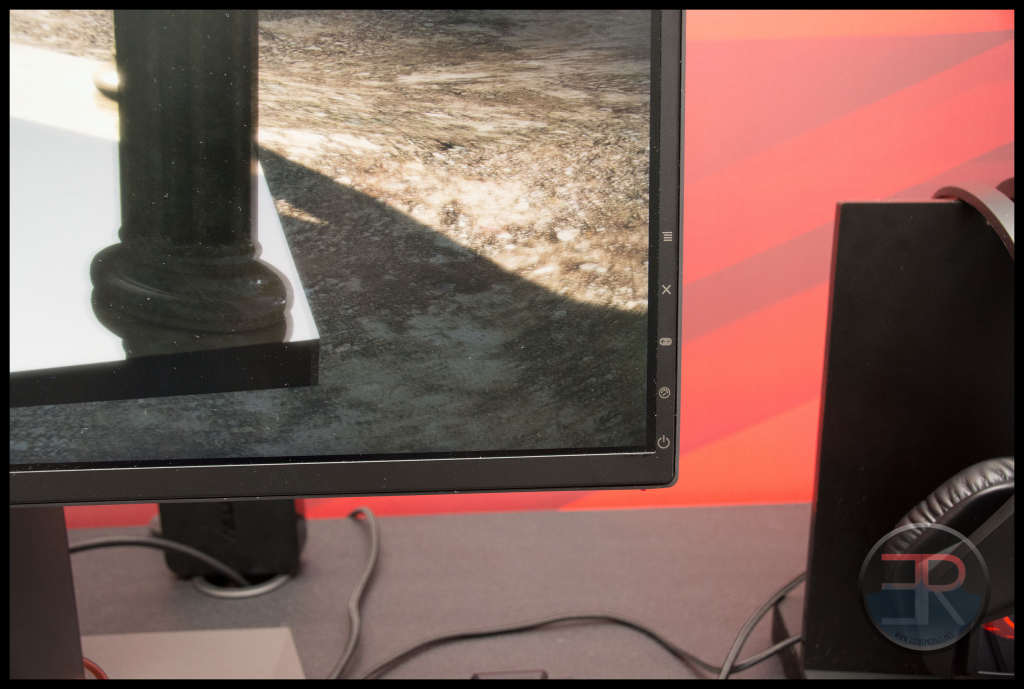 The OSD is a bit small, but that means it stays out of the way:
The OSD is a bit small, but that means it stays out of the way:
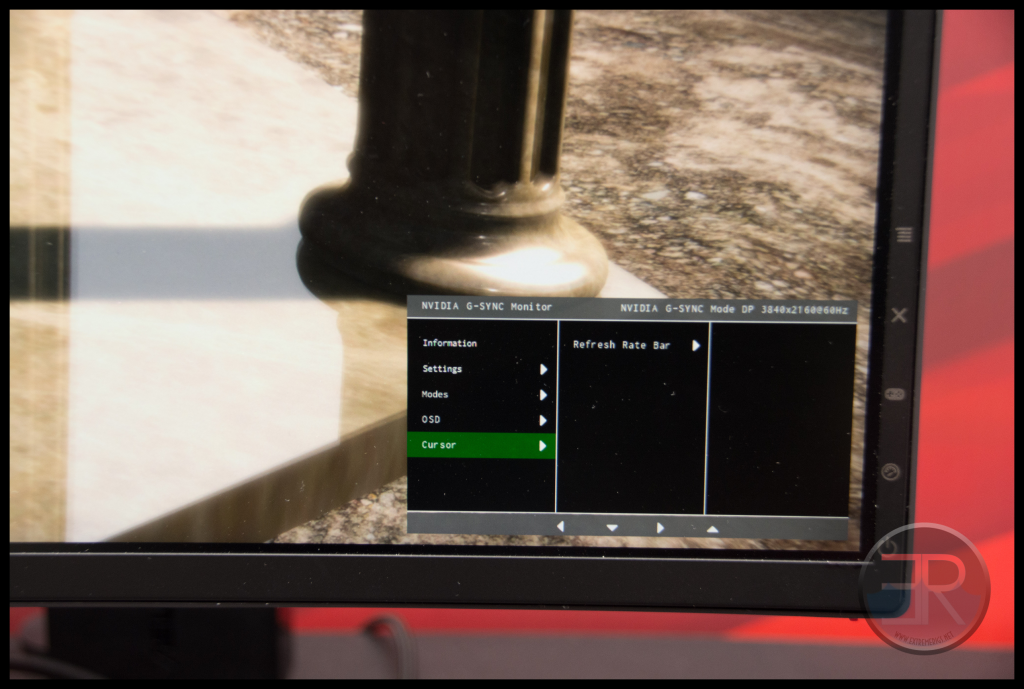
Viewing angles are of course great too as you’d expect from an IPS panel:
The back also continues the ROG look:
So now Asus have two ROG monitors that are perfect for both twitch shooter style gaming and a more immersive slow paced style of gaming.
I’m dying to try all these out. However not content with just these two Asus launched a few more:
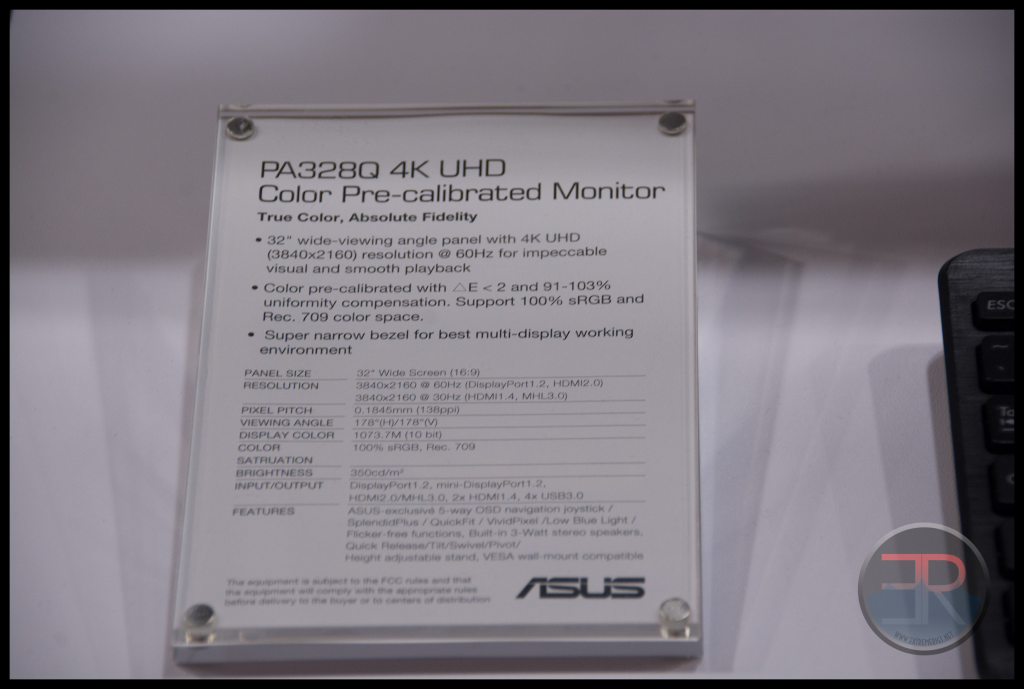
The PA328Q is another 4K monitor, but this time a bit larger at 32″ and more designed towards photo/video professionals:
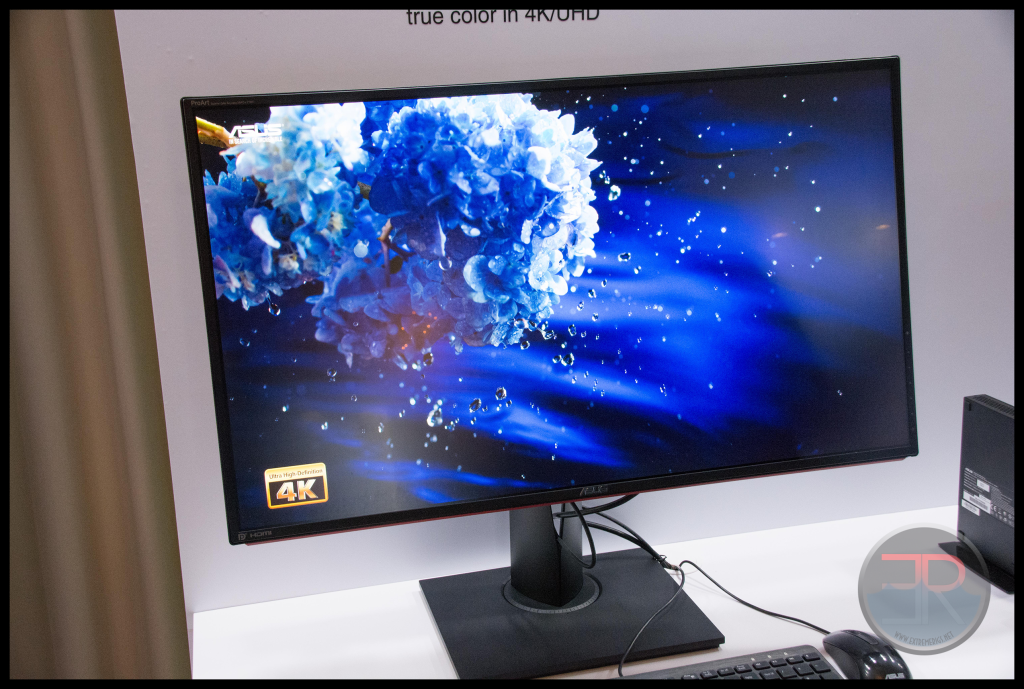 Although the bezels may not be substantially different to the Swift, the larger panel size means that relatively they seem smaller. 100% sRGB support and pre calibration also makes this a great offering for the professional or semipro video/photo editor. Viewing angles again are great:
Although the bezels may not be substantially different to the Swift, the larger panel size means that relatively they seem smaller. 100% sRGB support and pre calibration also makes this a great offering for the professional or semipro video/photo editor. Viewing angles again are great:
The other monitor of great interest is a gaming monitor but one that isn’t under the ROG/Swift brand:
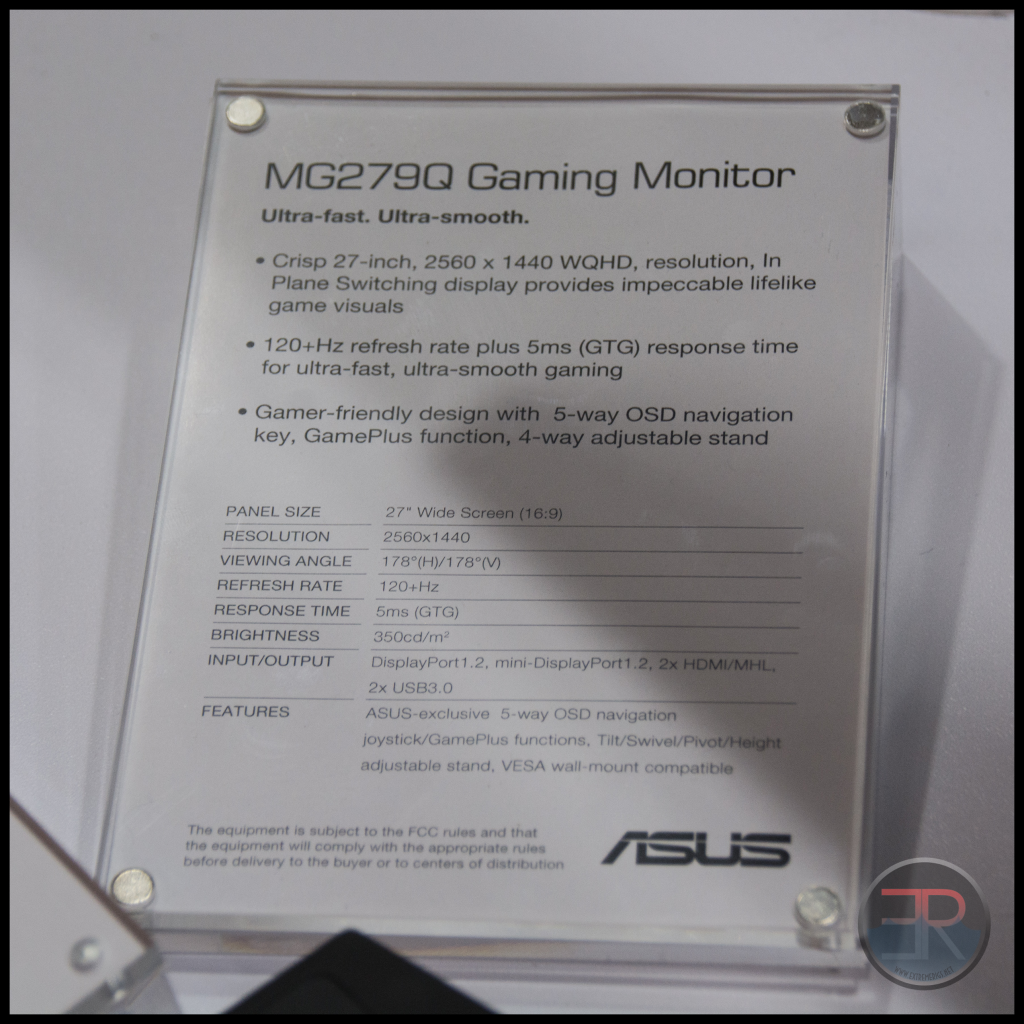 Yes it’s another 1440p IPS derivative panel running at 120Hz. These first became popular after forum users found they could “overclock” their dvi-d links to the barebones korean grey import monitors such as the Yamakasi/Catleap monitors. Overlord computer was then launched selling these monitors. However the bezels were big, and there were concerns about the lifetime when overclocking these devices. This year we are finally seeing monitors using display port, 120Hz and IPS panels where no overclocking is required.
Yes it’s another 1440p IPS derivative panel running at 120Hz. These first became popular after forum users found they could “overclock” their dvi-d links to the barebones korean grey import monitors such as the Yamakasi/Catleap monitors. Overlord computer was then launched selling these monitors. However the bezels were big, and there were concerns about the lifetime when overclocking these devices. This year we are finally seeing monitors using display port, 120Hz and IPS panels where no overclocking is required.
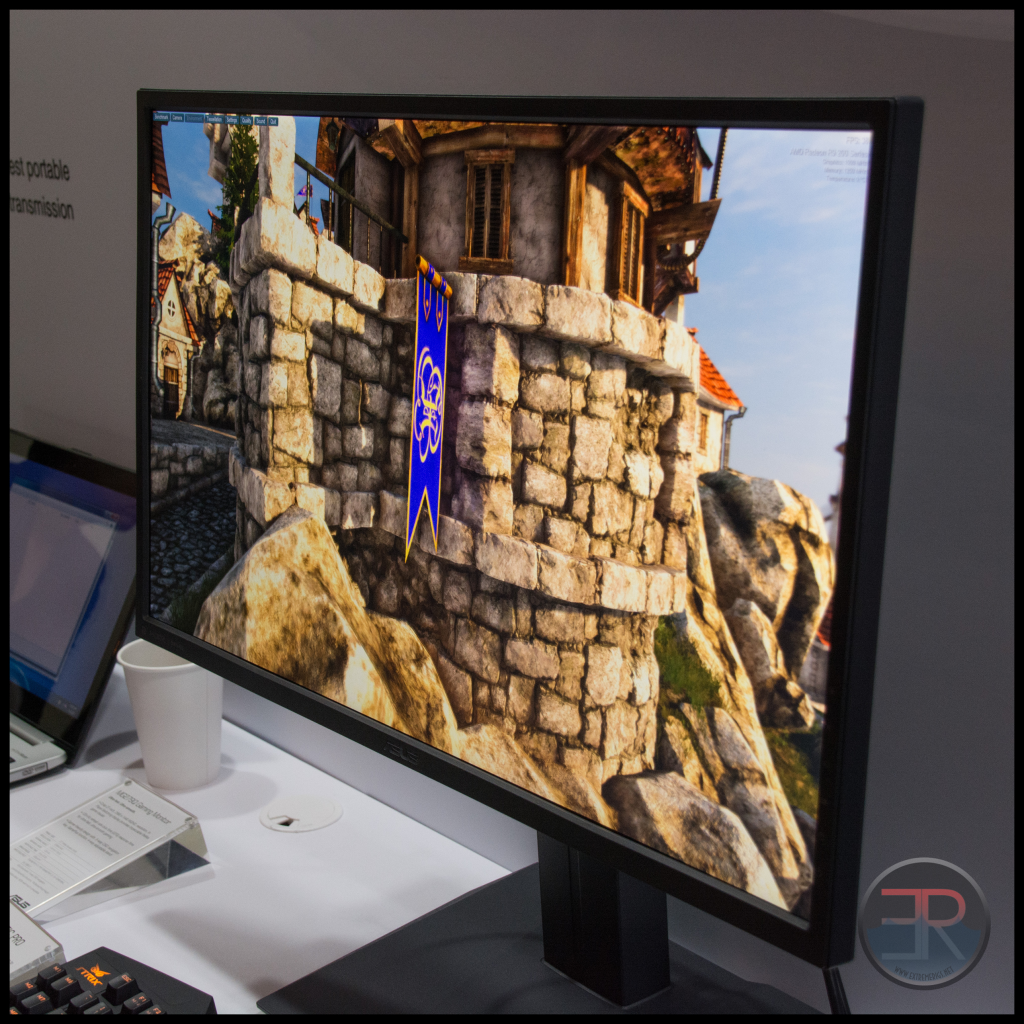
It’s also worth noting that these are not quite traditional IPS panels but a derivative, they still have the great viewing angles, but response time is slightly better, down from 8-10ms to 5ms. At 120Hzx5ms that means 600ms out of every 1000ms i.e. 60 percent of time is the pixel updating. Because of this, the screen will not be as clear as a 120Hz TN based panel where pixel response times will be <1ms. Strobing the LED backlight to reduce the blur during pixel updates would help, but this is not available yet. Note also that it says 120Hz+, Asus mentioned this means 144Hz, but that it’snot 100% confirmed/dialed in yet. For fast twitch FPS shooters we would still recommend the TN based Swift panel.
This monitor does not have GSync, but we noticed that it was running an AMD card and we were told that freesync support is planned for and would happen as soon as AMD would supply the necessary updates. Hopefully this will be soon and if it happens after the monitor ships, then we also hope it will be available by user applied firmware updates and not as some other companies do which requires shipping a monitor to another country for the update.
The base doesn’t look as cool as the ROG Swift but is still height adjustable as it should be at this price point.
The OSD is accessed via the right side in a similar manner to the swift. Choosing between this and the swift will be determined by your budget, application, and of course GPU vendor. Buying into freesync of course at this point in time risks another betamax/vhs decision. We think however that freesync is a safer bet than gsync just based on its adoption into displayport 1.2a. Hopefully Nvidia will include support for it in the next round of GPUs.
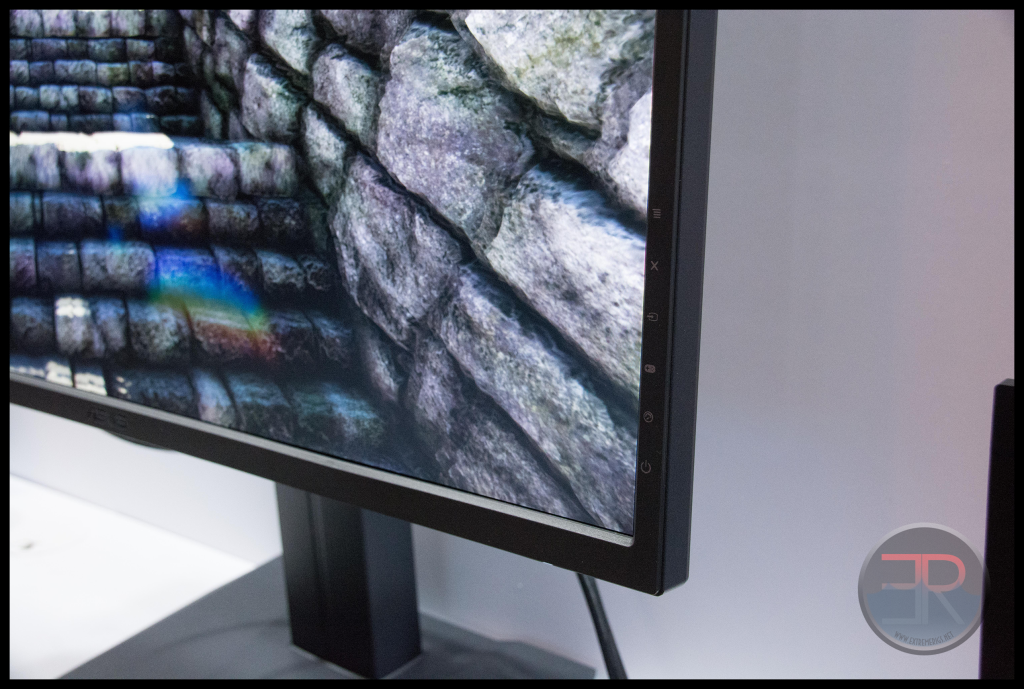
Viewing angles again are great:
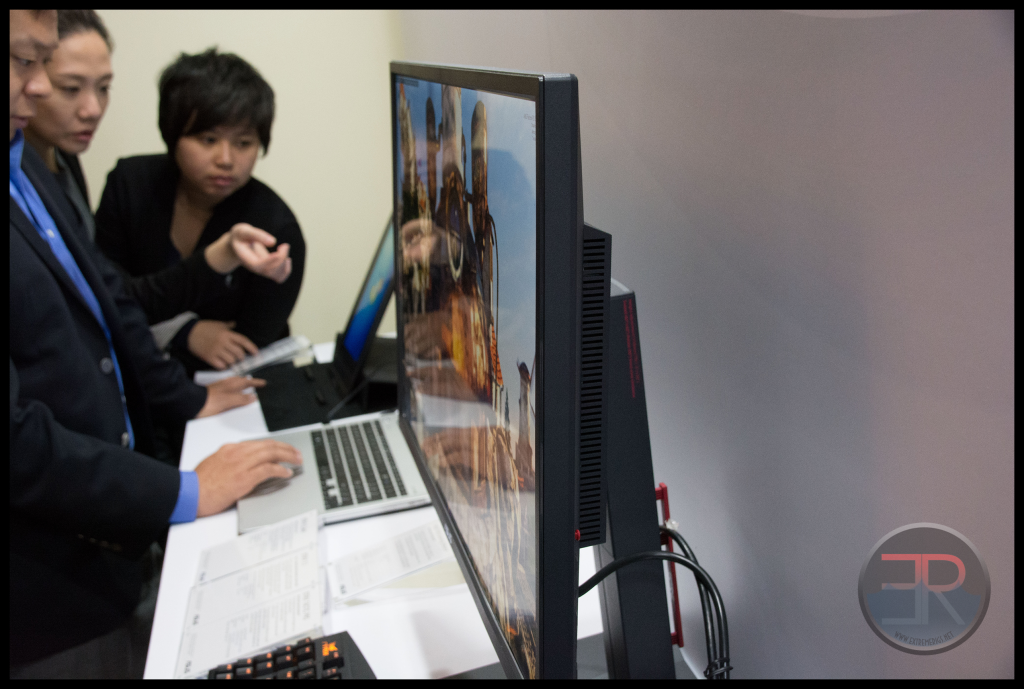
The last monitor Asus had for us was under there “prettier” design “MX” series:
It’s still 27″, IPS and 1440p but now only 60Hz 🙁 The upside is that it does away with the side bezels for a “frameless” design (though the display doesn’t of course go to the edge). It looks cool and is great for multiple displays in landscape only, but to be honest I’d rather have one of the other three:
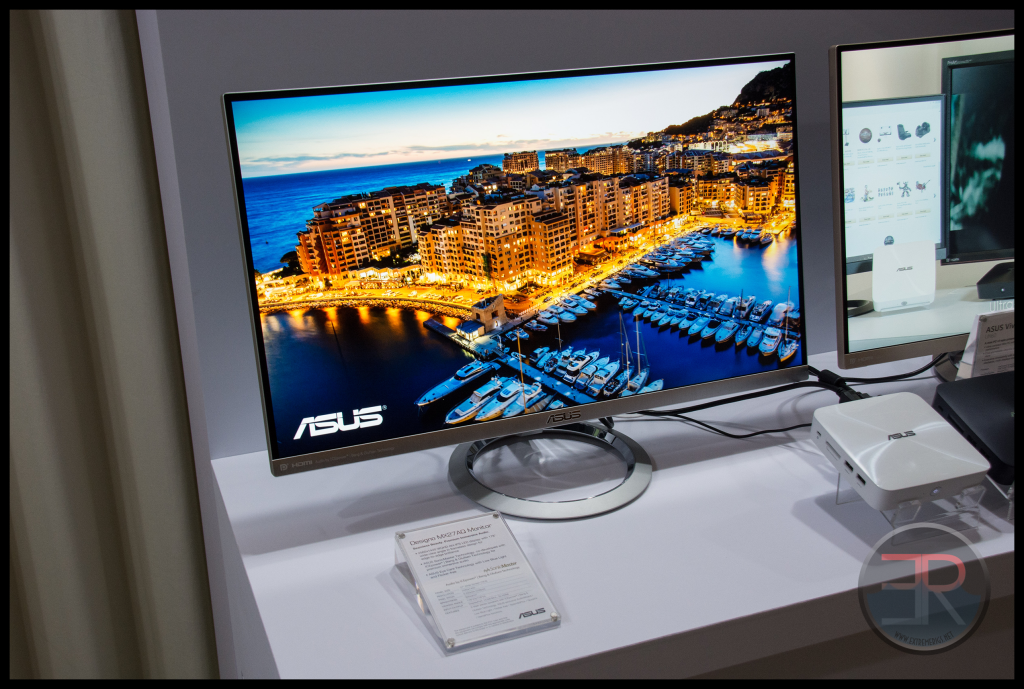 So that was it for displays from Asus. Some really good offerings for gamers, prosumers and professionals alike. So what else was up for show?
So that was it for displays from Asus. Some really good offerings for gamers, prosumers and professionals alike. So what else was up for show?
Peripherals:
ROG had already launched a mouse called “Gladius” back in september:
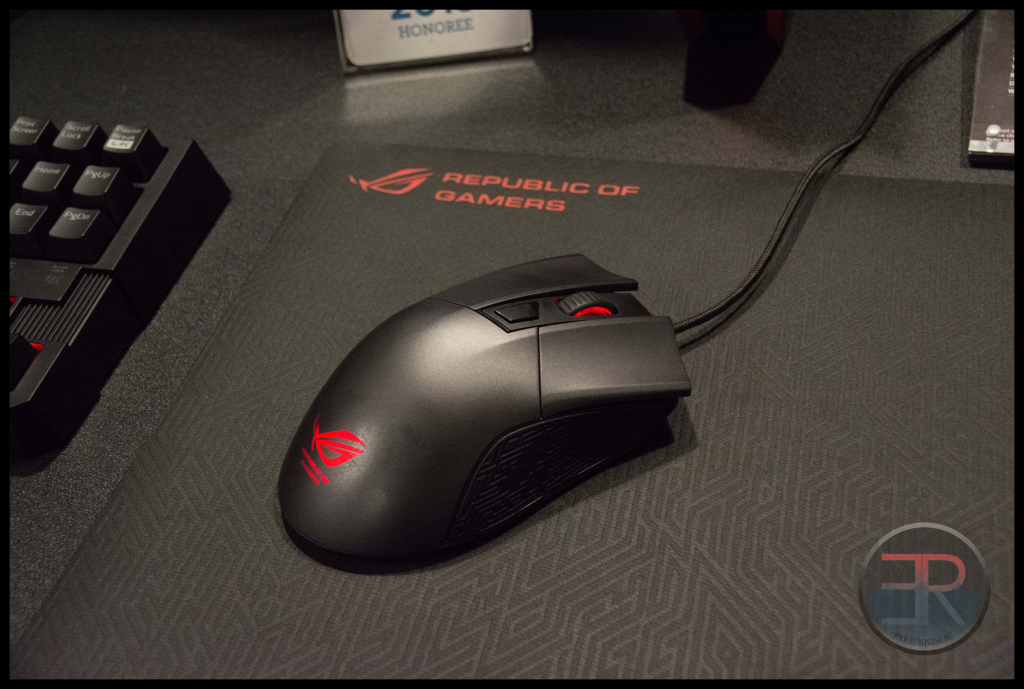 It had some cool features and well thought out design. Now after the higher end model ROG has been working on a cheaper option as well as a wireless mouse. The cheaper one is called the “Sica” which is ambidextrous but still features some of the features like swappable switches (not included) for the buttons:
It had some cool features and well thought out design. Now after the higher end model ROG has been working on a cheaper option as well as a wireless mouse. The cheaper one is called the “Sica” which is ambidextrous but still features some of the features like swappable switches (not included) for the buttons:
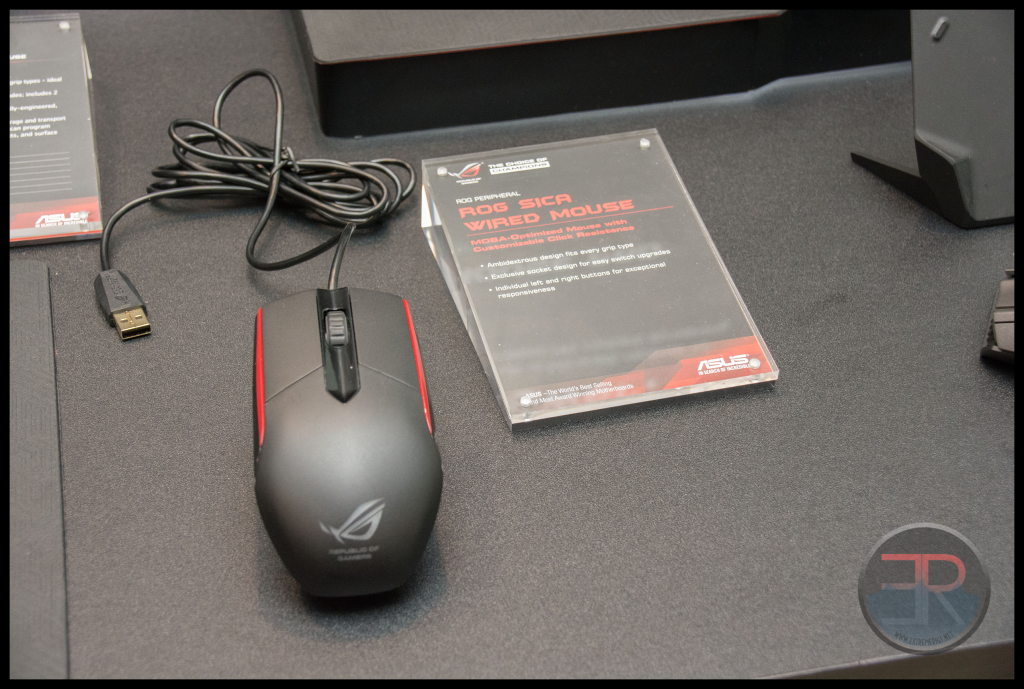
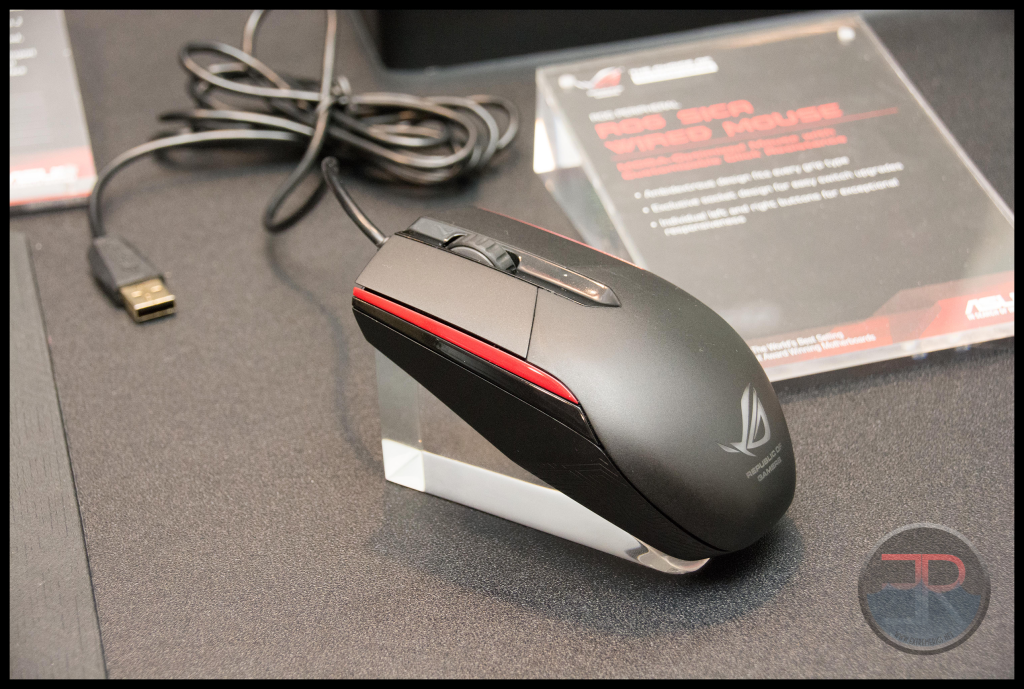 It’s not as pretty as the higher end design, but it’s not ugly and of course has LEDs. It’s claimed to be optimized for MOBA type games, but I’m not sure that part matters.
It’s not as pretty as the higher end design, but it’s not ugly and of course has LEDs. It’s claimed to be optimized for MOBA type games, but I’m not sure that part matters.
The wireless mouse is called the “Spatha”
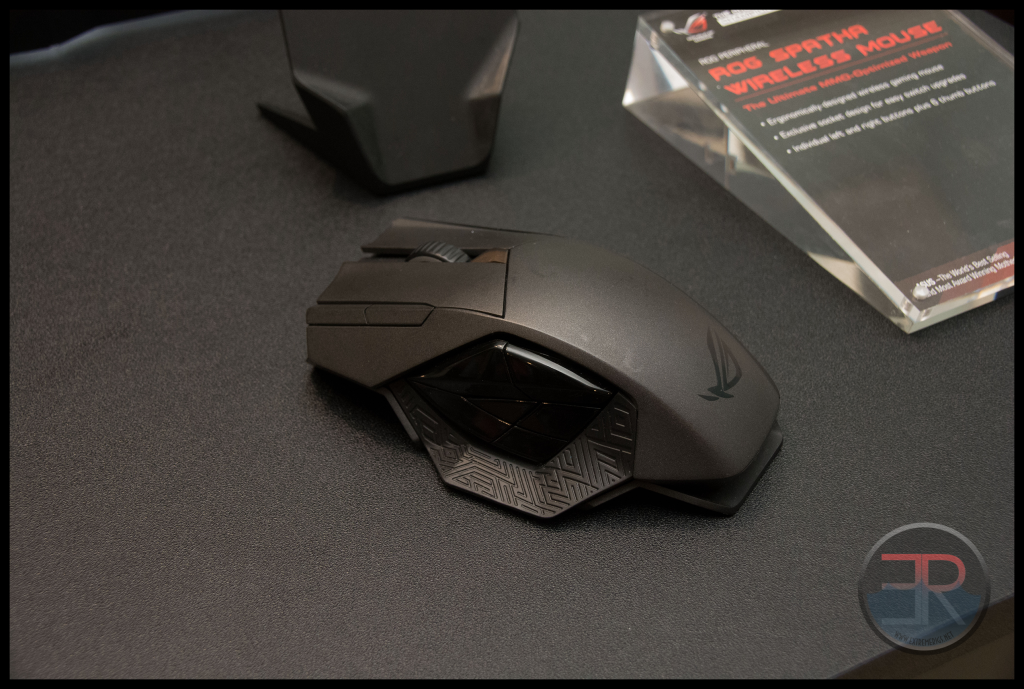 6 thumb buttons mark this out as more targeted towards MMO players, plus FPS/MOBA players would never trust wireless mice. The mouse unlike some other wireless mice is light “enough” given, and the cradle (hopefully for wireless charging) is nice, though seemed a little flimsy.
6 thumb buttons mark this out as more targeted towards MMO players, plus FPS/MOBA players would never trust wireless mice. The mouse unlike some other wireless mice is light “enough” given, and the cradle (hopefully for wireless charging) is nice, though seemed a little flimsy.
Of course ROG is not Asus’s only gaming brand. There is the newer Strix brand which now includes keyboards, mice and headsets:

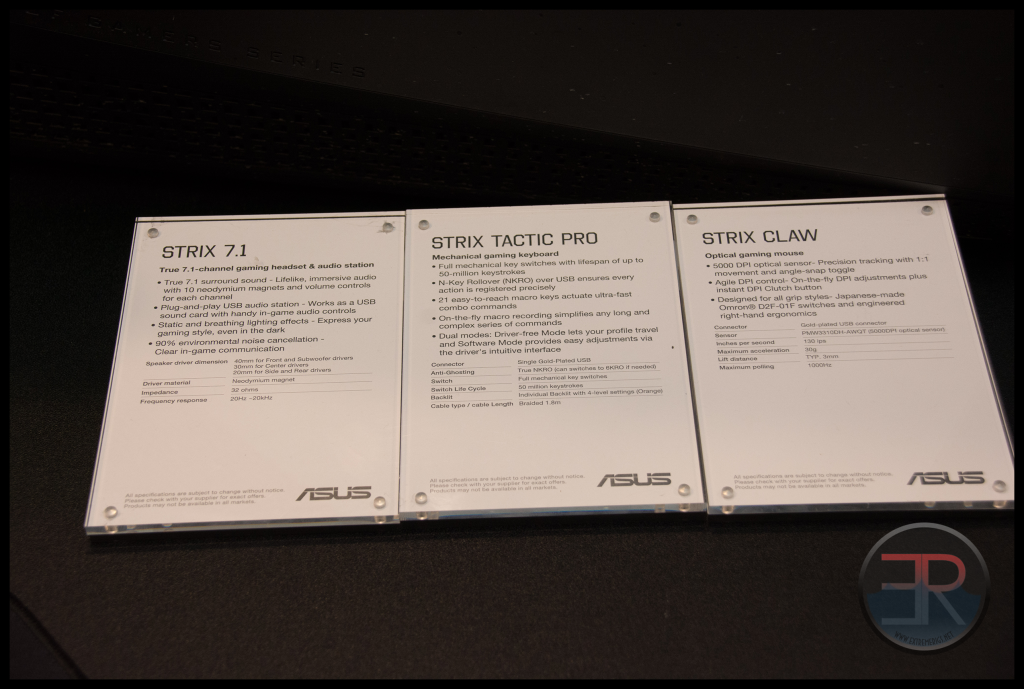 Of course none of these are new, but they are still cool. The headset is one of the few to do 7.1 sound with multiple drivers rather than digital trickery:
Of course none of these are new, but they are still cool. The headset is one of the few to do 7.1 sound with multiple drivers rather than digital trickery:
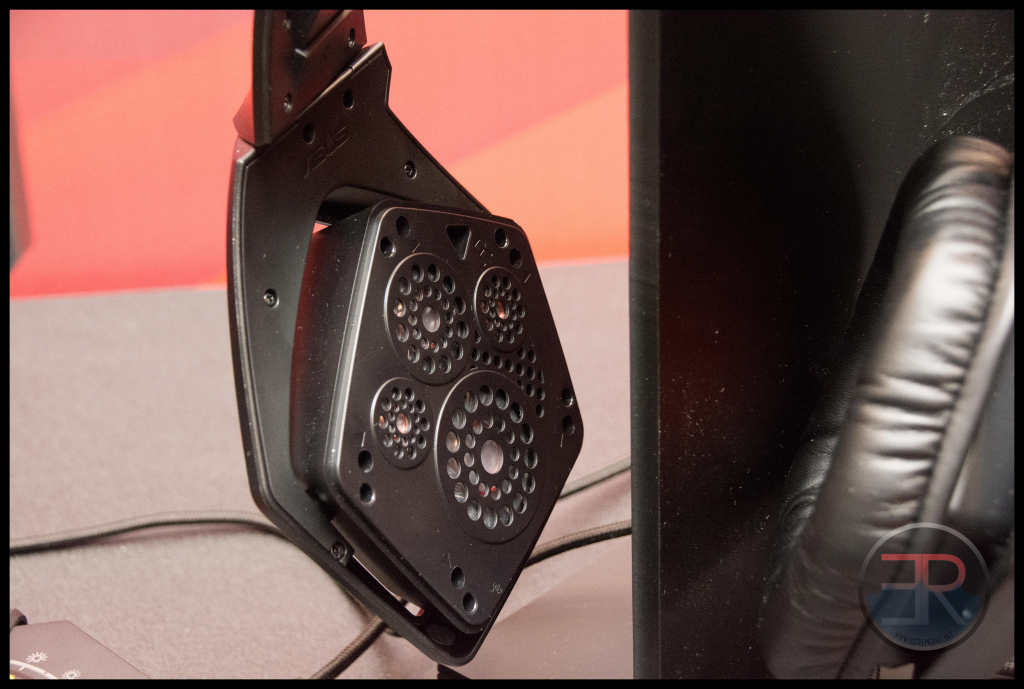 The desktop box too lets you dial in individual levels as you’d like. It’s all done in firmware too, so no need to install software if you’re going to a tournament, you can just plug in and get to work killing the competition:
The desktop box too lets you dial in individual levels as you’d like. It’s all done in firmware too, so no need to install software if you’re going to a tournament, you can just plug in and get to work killing the competition:
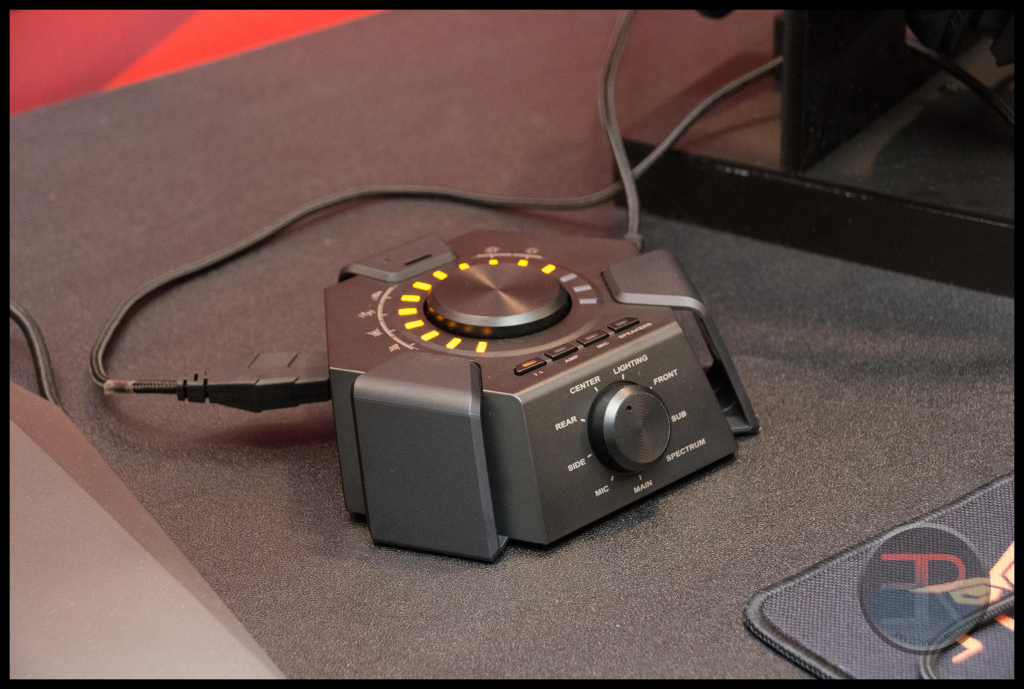 The lights on the headset can be dailed up or down and the pads and boom are of course replaceable:
The lights on the headset can be dailed up or down and the pads and boom are of course replaceable:
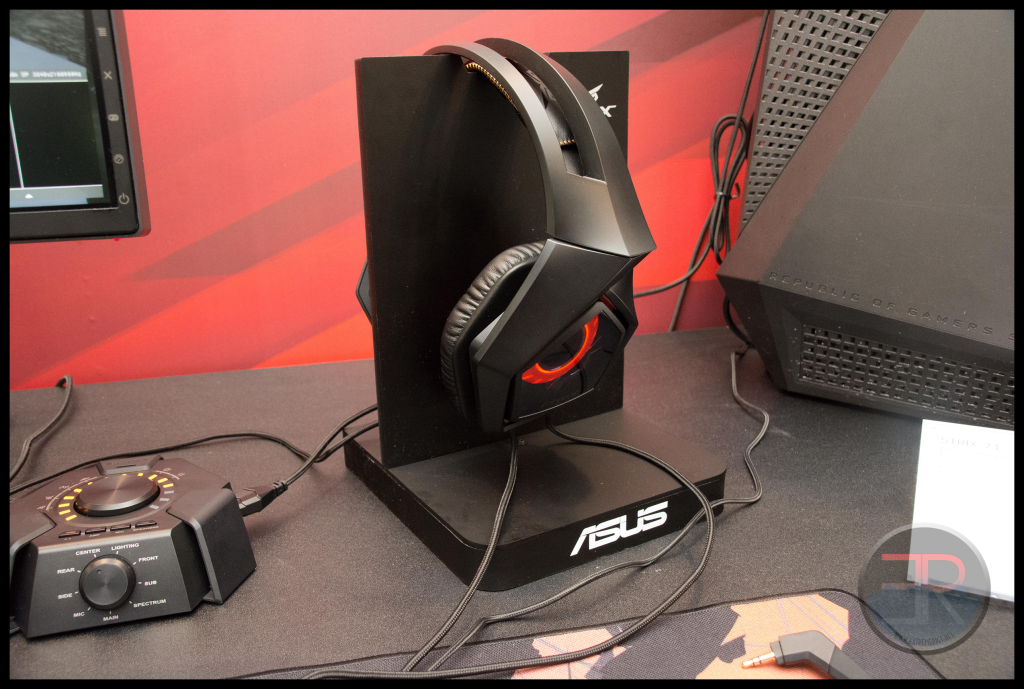
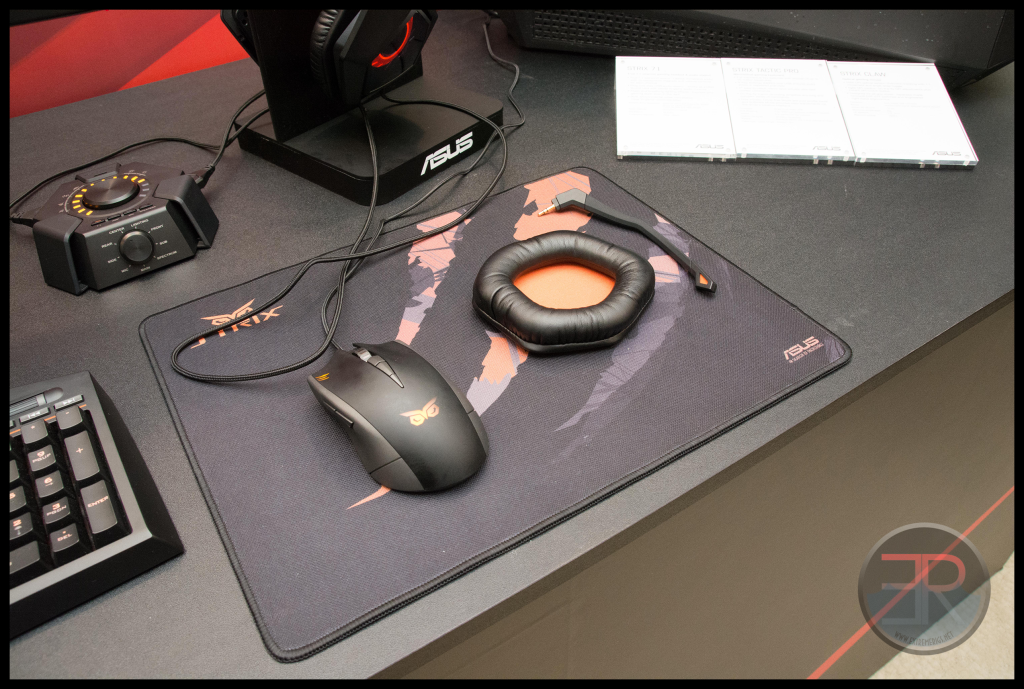 There was also a ROG mousepad:
There was also a ROG mousepad:
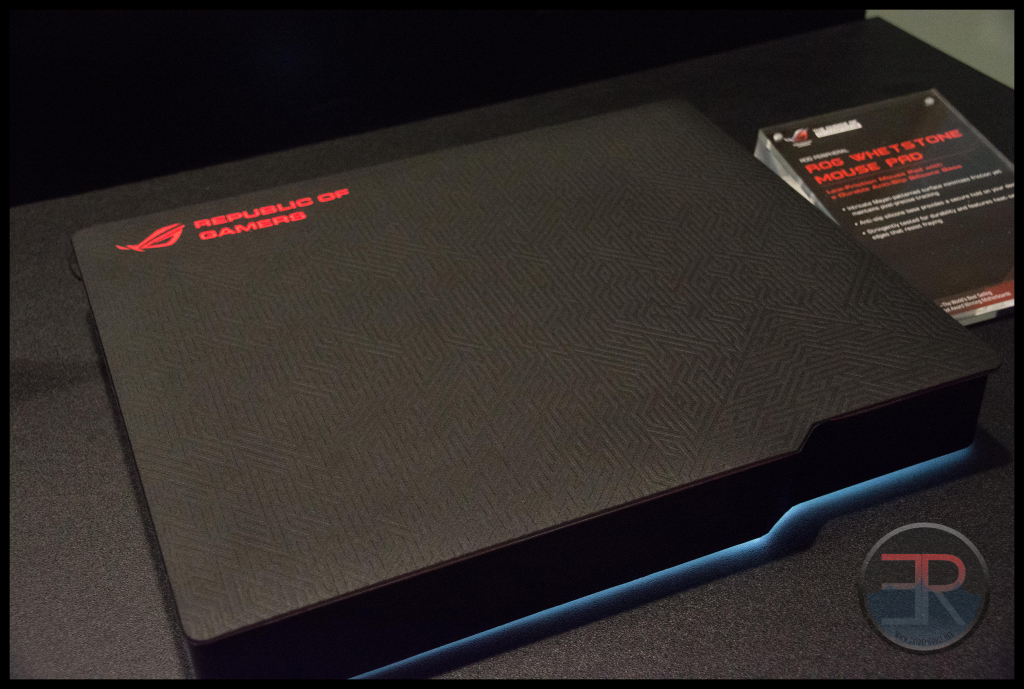 And of course the M801 TKL keyboard with mx reds:
And of course the M801 TKL keyboard with mx reds:
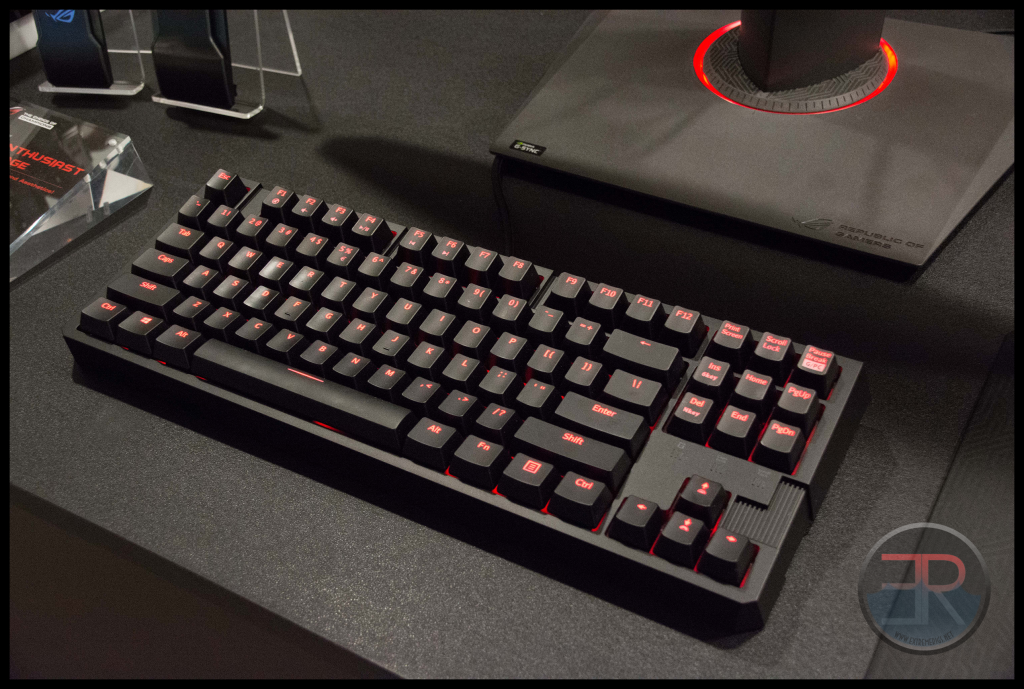 Then of course after the Nvidia and EVGA branded SLI bridges were so popular, ROG had to come out with theirs too in 2/3/4 slot varieties:
Then of course after the Nvidia and EVGA branded SLI bridges were so popular, ROG had to come out with theirs too in 2/3/4 slot varieties:
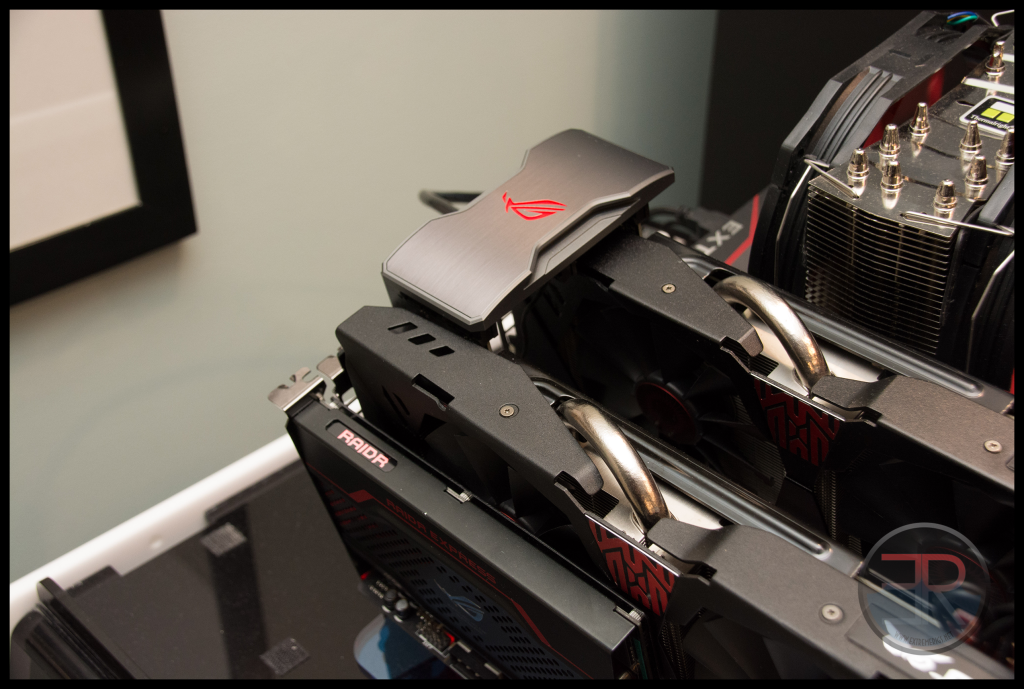 Quite nice and smooth and sleek.
Quite nice and smooth and sleek.
Lastly we had the networking gear. Asus’s products have always been very high end in this zone, recently they’ve heavily focussed on some badass high speed routers. This year was no different with 802.11 AC being the focus as usual:
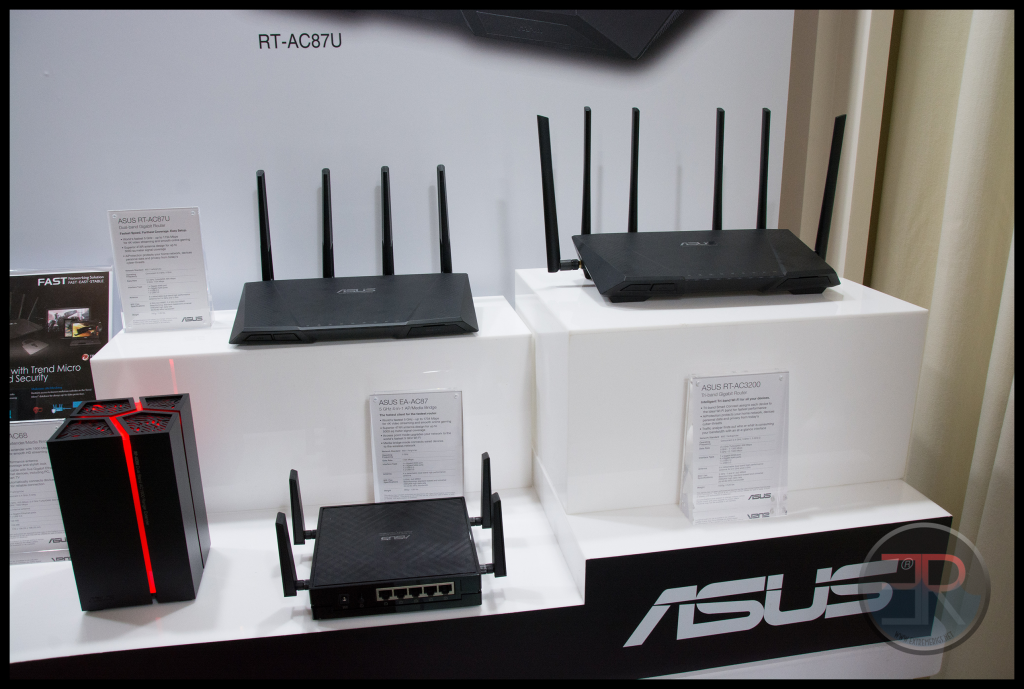
Let’s start with the coolest looking one:
Keeping up with the ROG theme, this RP-AC68 unit is designed to look cool on it’s own and not look like a traditional Wifi bridge. Of course it won’t work in every home, but hell I’d put it somewhere prominent because it does look cool:
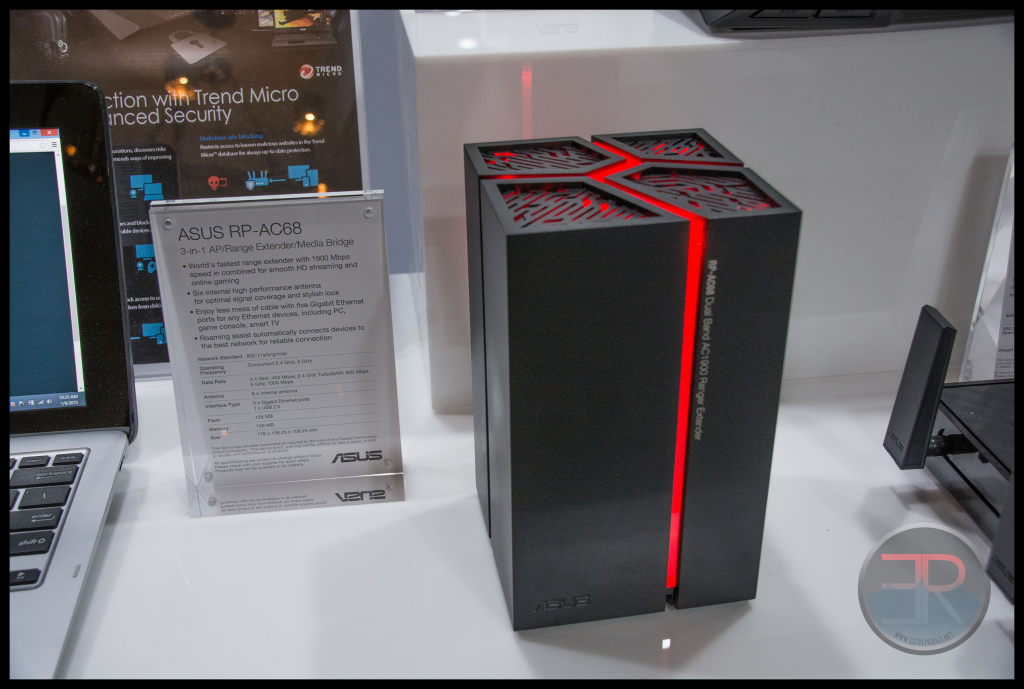 The cool thing is if you use it as an extender, that it will do auto handoff with the main router, meaning your mobile device doesn’t get stuck on a low quality signal when it could switch to your main router instead. It also boasts 1.9GBPS by combining 2.4 and 5.0GHz. So yeah, no complaints on speed or functionality.
The cool thing is if you use it as an extender, that it will do auto handoff with the main router, meaning your mobile device doesn’t get stuck on a low quality signal when it could switch to your main router instead. It also boasts 1.9GBPS by combining 2.4 and 5.0GHz. So yeah, no complaints on speed or functionality.
There was also the high end main router RT-AC87U which also can combine 2.4 and 5.0 GHz to hit 1.7GBPS and boasts 5000 square meters of coverage. It can also handle devices with MIMO and you can monitor, prioritize, throttle and optimize individual users applications through the GUI:
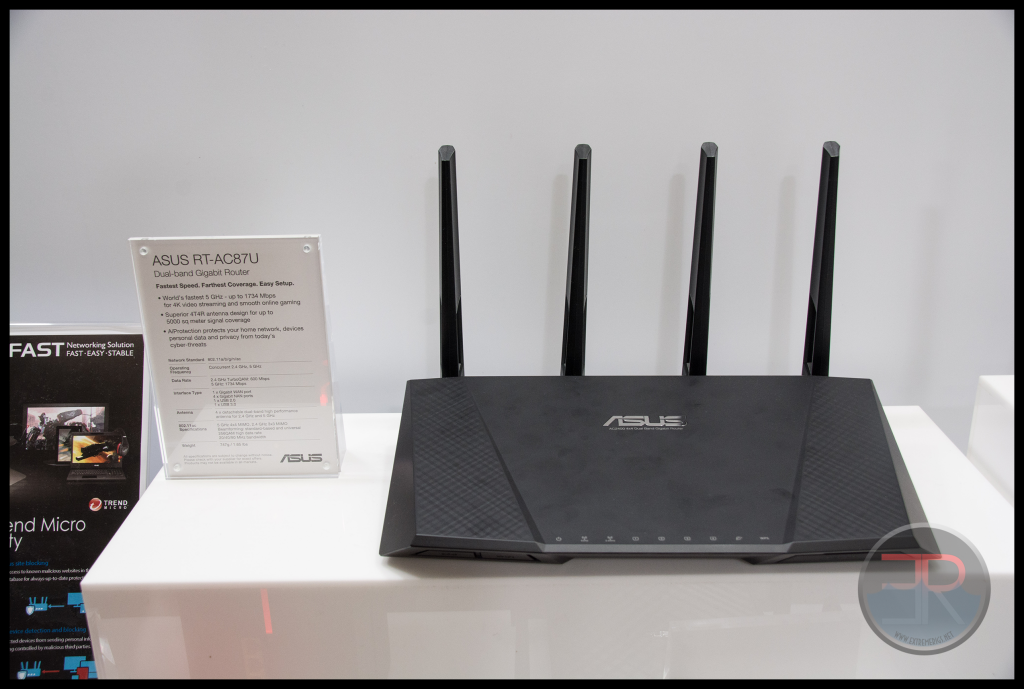 Now if 4 antennas aren’t enough you can upgrade to the 6 antenna triband RT-AC3200. This one is a bit more compatible with old devices and can assign older devices to older bands and prioritize modern devices to more modern bands so that they don’t interfere.
Now if 4 antennas aren’t enough you can upgrade to the 6 antenna triband RT-AC3200. This one is a bit more compatible with old devices and can assign older devices to older bands and prioritize modern devices to more modern bands so that they don’t interfere.
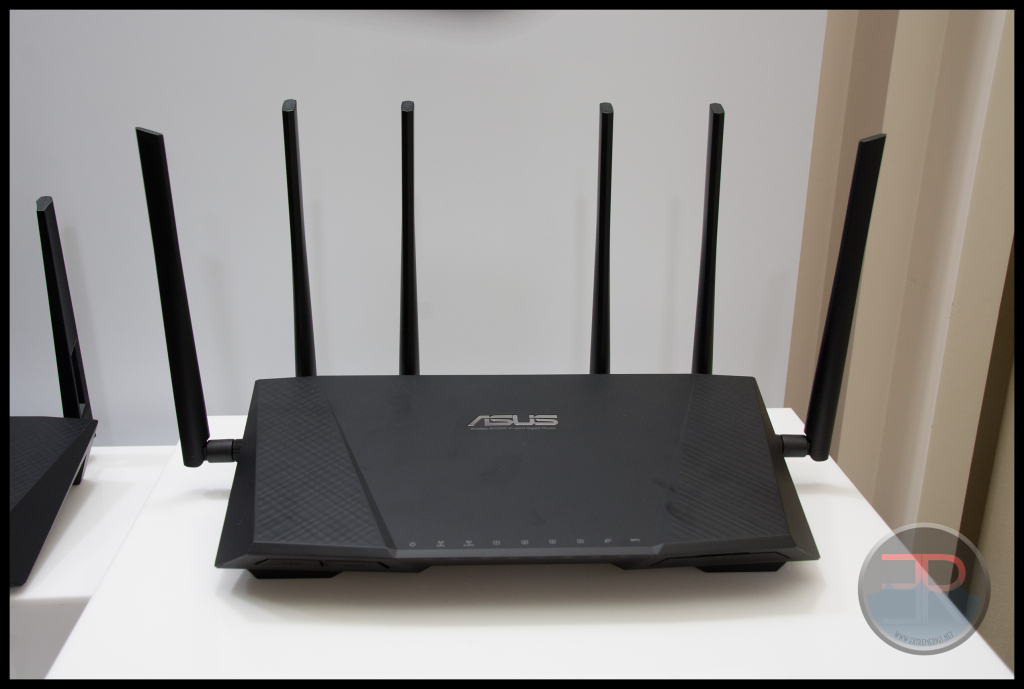 Then lastly the boxy and uglier RT-AC87 without the U:
Then lastly the boxy and uglier RT-AC87 without the U:
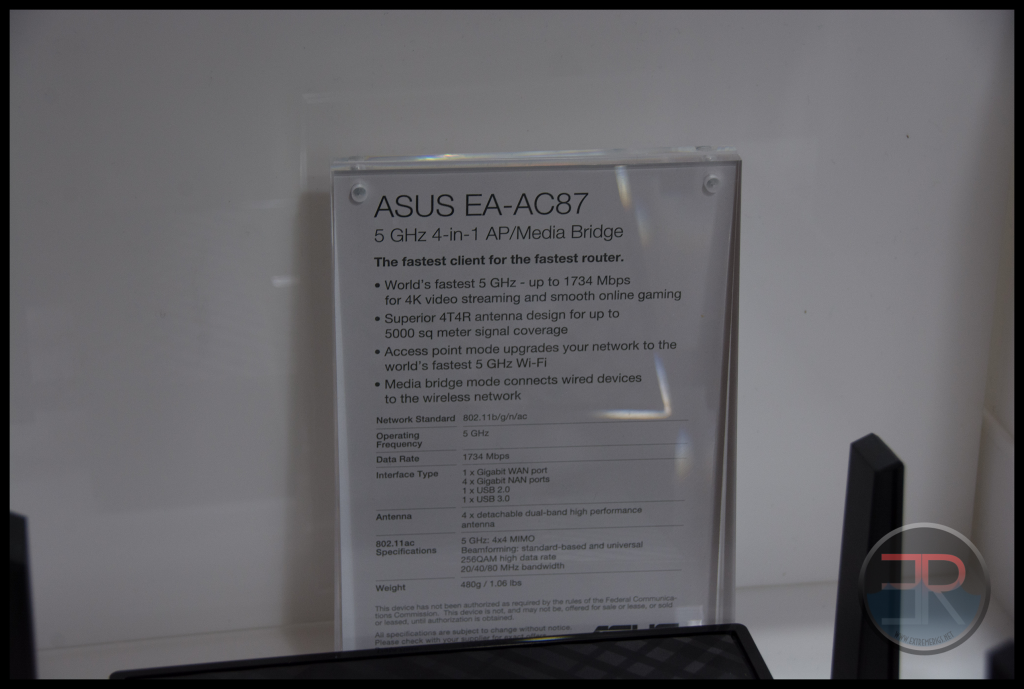 This is the stubby one with LAN ports on the front in the earlier photo. Essentially it looks to have the same performance as the U version, but just adds gigabit wired connections.
This is the stubby one with LAN ports on the front in the earlier photo. Essentially it looks to have the same performance as the U version, but just adds gigabit wired connections.
So while that covers all the new stuff, let’s end up with some of the modded builds from the suite both featuring the sabretooth mark s board:
